Hospitality Industry Finance: Funding, Income, Budgeting, and Analysis
VerifiedAdded on 2020/06/06
|25
|4694
|127
Report
AI Summary
This report provides a comprehensive analysis of finance within the hospitality industry. It begins by exploring internal and external funding sources, detailing techniques for income generation. The report then delves into cost components, gross profit elements, and selling price determination, using Marks and Spencer as a case study. Methods for stock and cash control are examined. The report further discusses budgeting procedures, objectives, and variance analysis, including material and labor variances. Finally, the report includes the preparation of financial statements (journal entries, trial balance, profit and loss account, and balance sheet) for R. Riggs for the year ending December 31, 2015, followed by a ratio analysis of the company's past performance and a contribution and expenditure analysis.
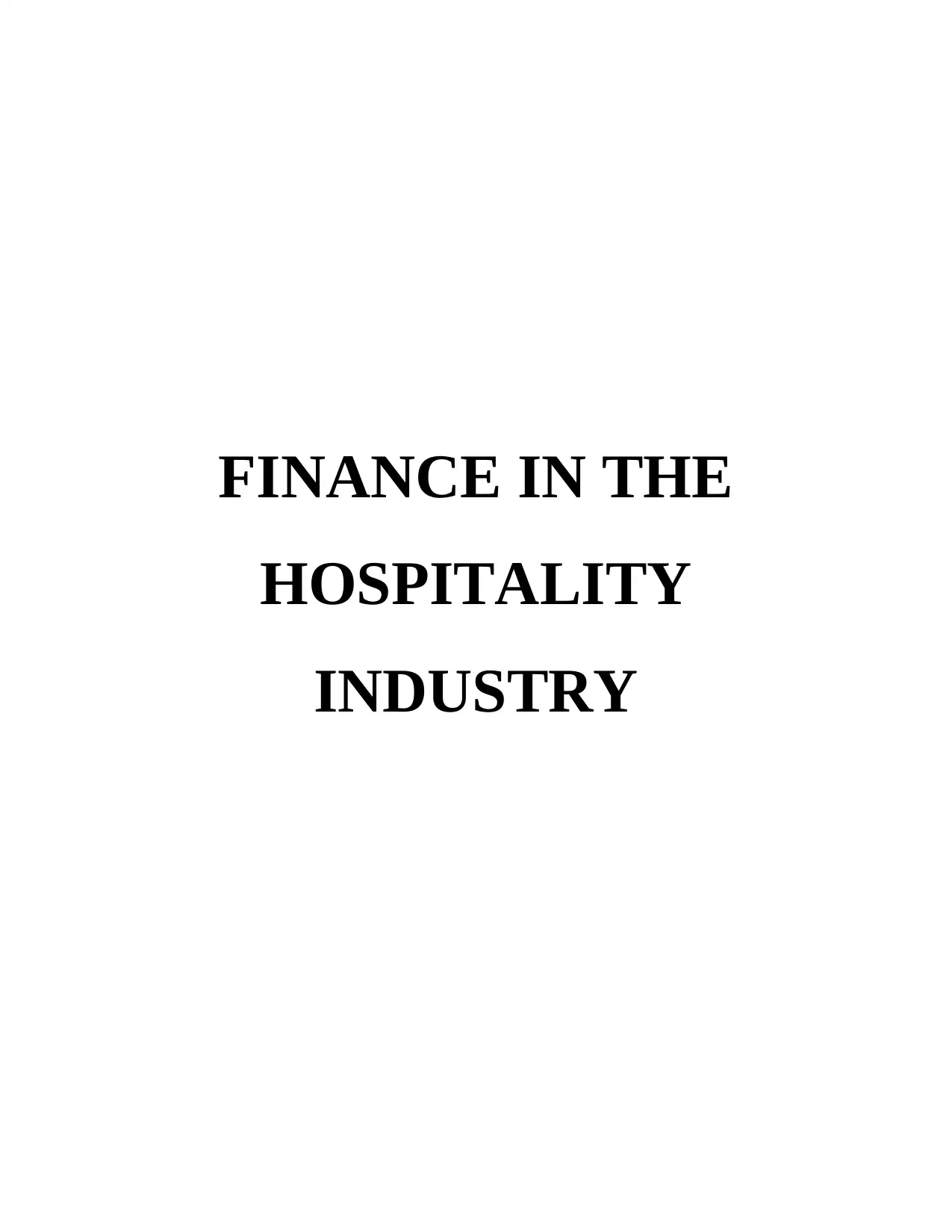
FINANCE IN THE
HOSPITALITY
INDUSTRY
HOSPITALITY
INDUSTRY
Paraphrase This Document
Need a fresh take? Get an instant paraphrase of this document with our AI Paraphraser
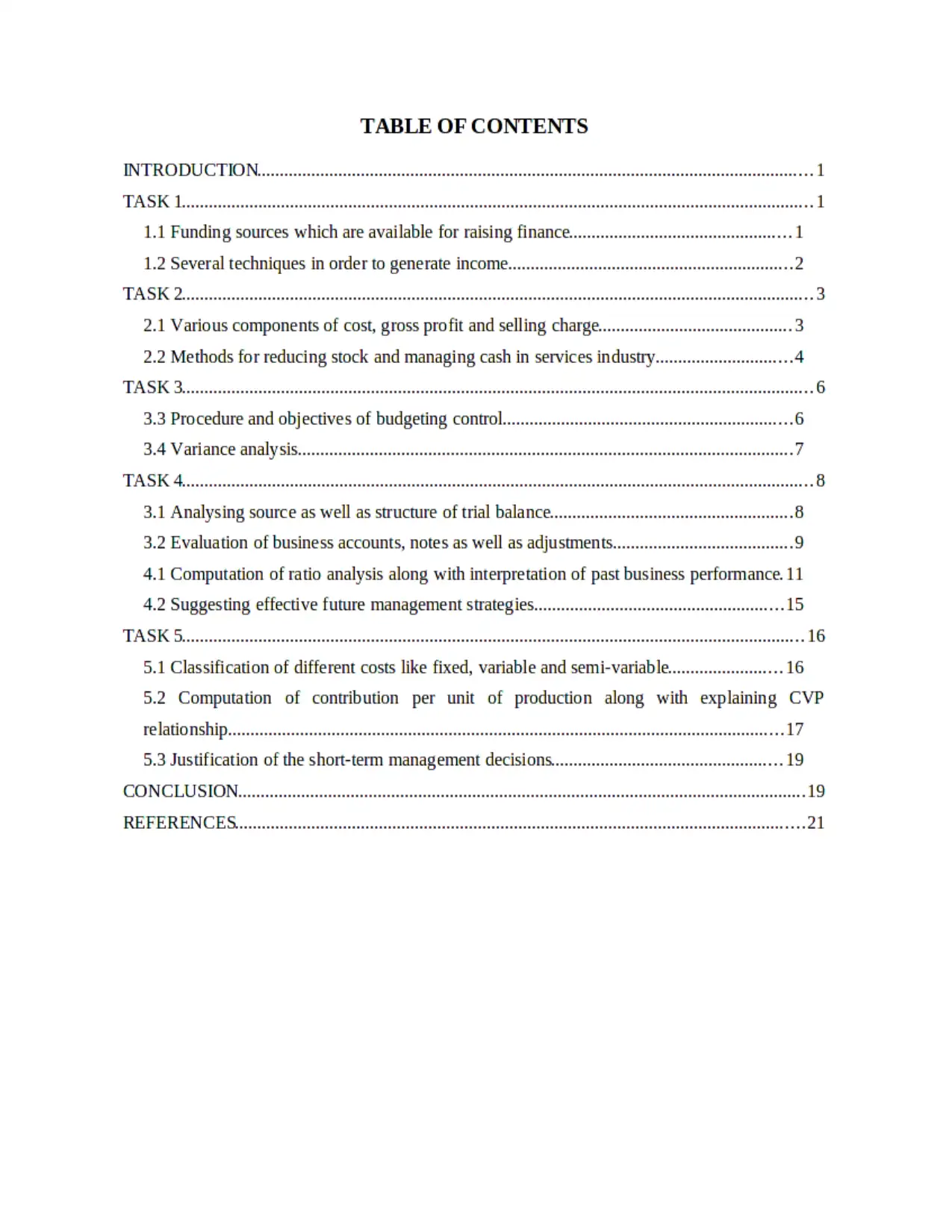
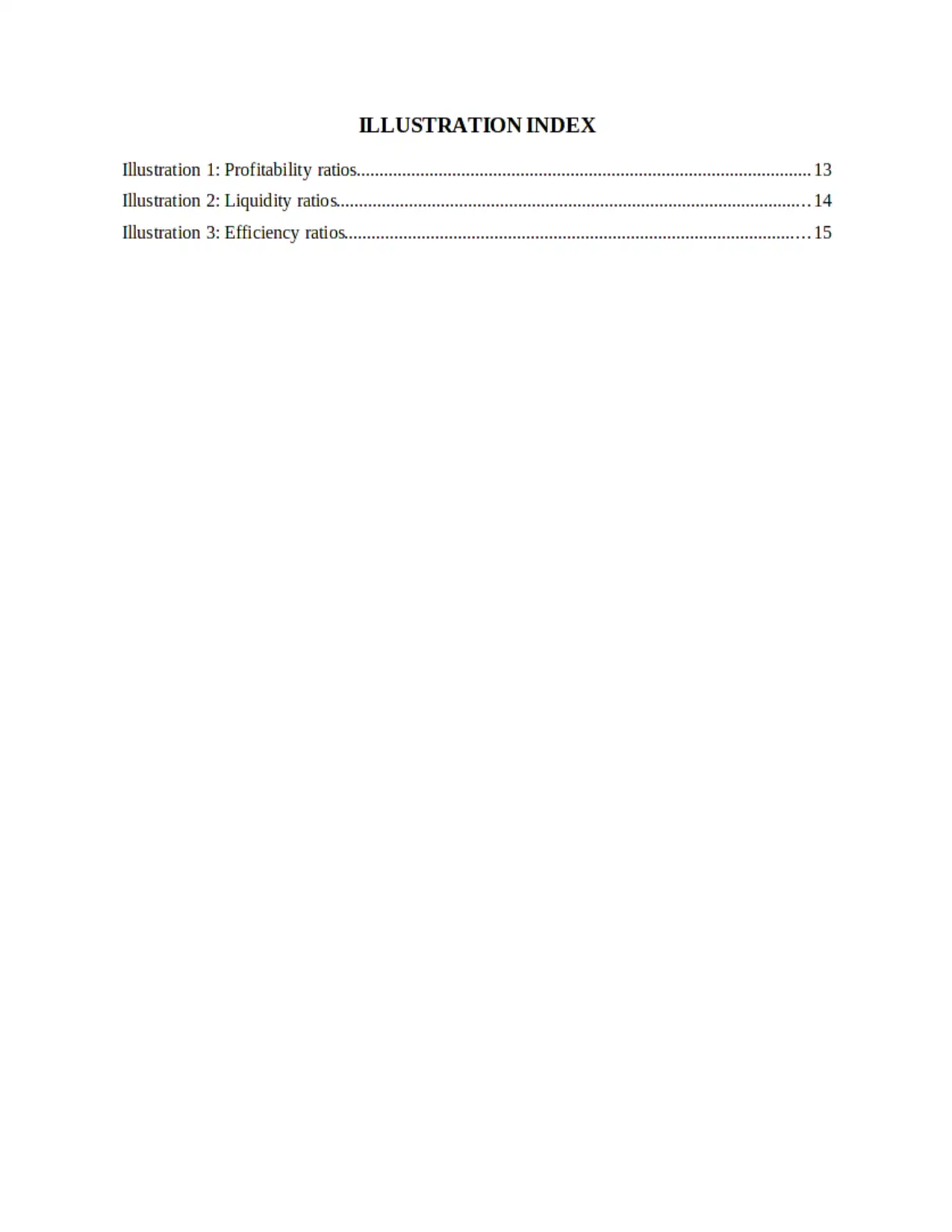
⊘ This is a preview!⊘
Do you want full access?
Subscribe today to unlock all pages.

Trusted by 1+ million students worldwide
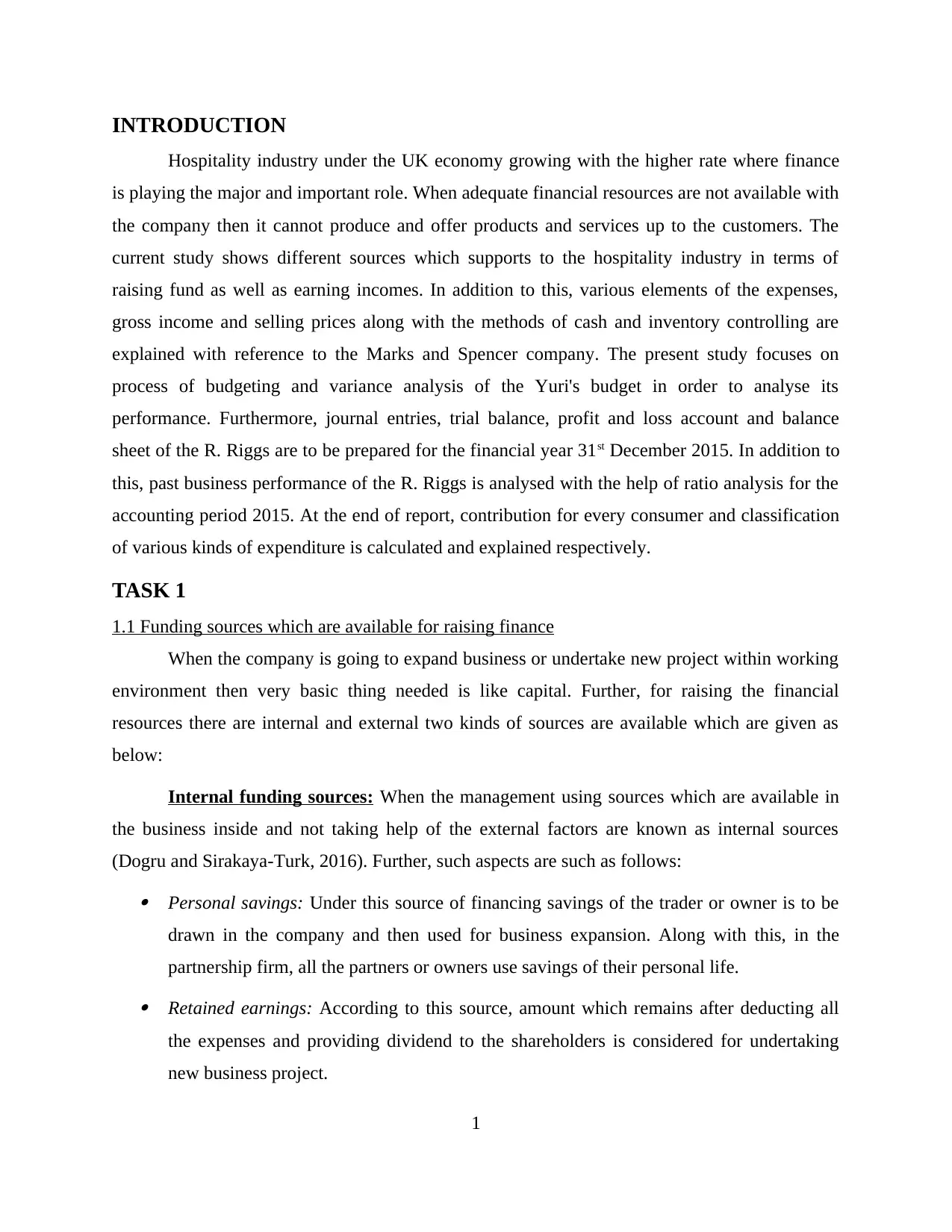
INTRODUCTION
Hospitality industry under the UK economy growing with the higher rate where finance
is playing the major and important role. When adequate financial resources are not available with
the company then it cannot produce and offer products and services up to the customers. The
current study shows different sources which supports to the hospitality industry in terms of
raising fund as well as earning incomes. In addition to this, various elements of the expenses,
gross income and selling prices along with the methods of cash and inventory controlling are
explained with reference to the Marks and Spencer company. The present study focuses on
process of budgeting and variance analysis of the Yuri's budget in order to analyse its
performance. Furthermore, journal entries, trial balance, profit and loss account and balance
sheet of the R. Riggs are to be prepared for the financial year 31st December 2015. In addition to
this, past business performance of the R. Riggs is analysed with the help of ratio analysis for the
accounting period 2015. At the end of report, contribution for every consumer and classification
of various kinds of expenditure is calculated and explained respectively.
TASK 1
1.1 Funding sources which are available for raising finance
When the company is going to expand business or undertake new project within working
environment then very basic thing needed is like capital. Further, for raising the financial
resources there are internal and external two kinds of sources are available which are given as
below:
Internal funding sources: When the management using sources which are available in
the business inside and not taking help of the external factors are known as internal sources
(Dogru and Sirakaya-Turk, 2016). Further, such aspects are such as follows: Personal savings: Under this source of financing savings of the trader or owner is to be
drawn in the company and then used for business expansion. Along with this, in the
partnership firm, all the partners or owners use savings of their personal life. Retained earnings: According to this source, amount which remains after deducting all
the expenses and providing dividend to the shareholders is considered for undertaking
new business project.
1
Hospitality industry under the UK economy growing with the higher rate where finance
is playing the major and important role. When adequate financial resources are not available with
the company then it cannot produce and offer products and services up to the customers. The
current study shows different sources which supports to the hospitality industry in terms of
raising fund as well as earning incomes. In addition to this, various elements of the expenses,
gross income and selling prices along with the methods of cash and inventory controlling are
explained with reference to the Marks and Spencer company. The present study focuses on
process of budgeting and variance analysis of the Yuri's budget in order to analyse its
performance. Furthermore, journal entries, trial balance, profit and loss account and balance
sheet of the R. Riggs are to be prepared for the financial year 31st December 2015. In addition to
this, past business performance of the R. Riggs is analysed with the help of ratio analysis for the
accounting period 2015. At the end of report, contribution for every consumer and classification
of various kinds of expenditure is calculated and explained respectively.
TASK 1
1.1 Funding sources which are available for raising finance
When the company is going to expand business or undertake new project within working
environment then very basic thing needed is like capital. Further, for raising the financial
resources there are internal and external two kinds of sources are available which are given as
below:
Internal funding sources: When the management using sources which are available in
the business inside and not taking help of the external factors are known as internal sources
(Dogru and Sirakaya-Turk, 2016). Further, such aspects are such as follows: Personal savings: Under this source of financing savings of the trader or owner is to be
drawn in the company and then used for business expansion. Along with this, in the
partnership firm, all the partners or owners use savings of their personal life. Retained earnings: According to this source, amount which remains after deducting all
the expenses and providing dividend to the shareholders is considered for undertaking
new business project.
1
Paraphrase This Document
Need a fresh take? Get an instant paraphrase of this document with our AI Paraphraser
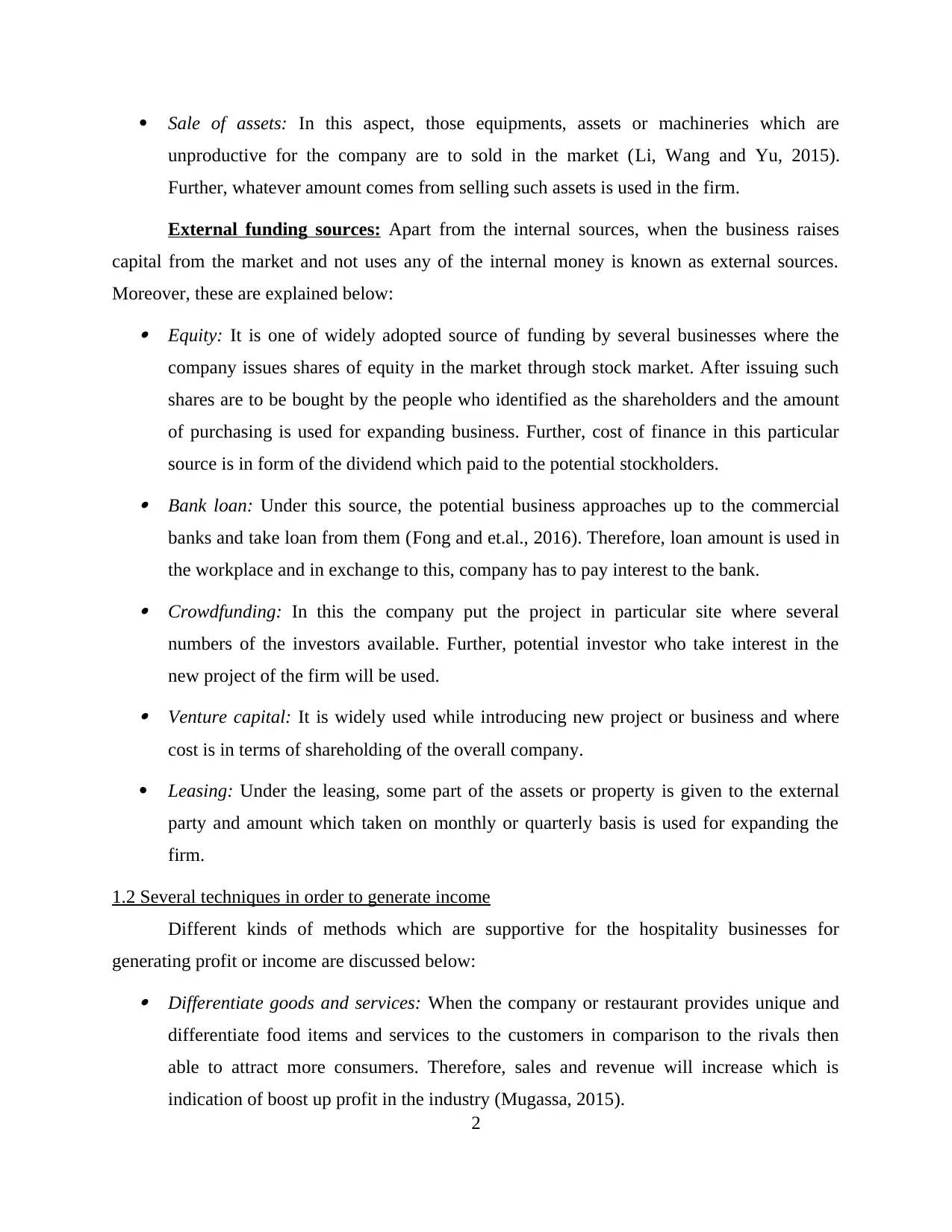
Sale of assets: In this aspect, those equipments, assets or machineries which are
unproductive for the company are to sold in the market (Li, Wang and Yu, 2015).
Further, whatever amount comes from selling such assets is used in the firm.
External funding sources: Apart from the internal sources, when the business raises
capital from the market and not uses any of the internal money is known as external sources.
Moreover, these are explained below: Equity: It is one of widely adopted source of funding by several businesses where the
company issues shares of equity in the market through stock market. After issuing such
shares are to be bought by the people who identified as the shareholders and the amount
of purchasing is used for expanding business. Further, cost of finance in this particular
source is in form of the dividend which paid to the potential stockholders. Bank loan: Under this source, the potential business approaches up to the commercial
banks and take loan from them (Fong and et.al., 2016). Therefore, loan amount is used in
the workplace and in exchange to this, company has to pay interest to the bank. Crowdfunding: In this the company put the project in particular site where several
numbers of the investors available. Further, potential investor who take interest in the
new project of the firm will be used. Venture capital: It is widely used while introducing new project or business and where
cost is in terms of shareholding of the overall company.
Leasing: Under the leasing, some part of the assets or property is given to the external
party and amount which taken on monthly or quarterly basis is used for expanding the
firm.
1.2 Several techniques in order to generate income
Different kinds of methods which are supportive for the hospitality businesses for
generating profit or income are discussed below: Differentiate goods and services: When the company or restaurant provides unique and
differentiate food items and services to the customers in comparison to the rivals then
able to attract more consumers. Therefore, sales and revenue will increase which is
indication of boost up profit in the industry (Mugassa, 2015).
2
unproductive for the company are to sold in the market (Li, Wang and Yu, 2015).
Further, whatever amount comes from selling such assets is used in the firm.
External funding sources: Apart from the internal sources, when the business raises
capital from the market and not uses any of the internal money is known as external sources.
Moreover, these are explained below: Equity: It is one of widely adopted source of funding by several businesses where the
company issues shares of equity in the market through stock market. After issuing such
shares are to be bought by the people who identified as the shareholders and the amount
of purchasing is used for expanding business. Further, cost of finance in this particular
source is in form of the dividend which paid to the potential stockholders. Bank loan: Under this source, the potential business approaches up to the commercial
banks and take loan from them (Fong and et.al., 2016). Therefore, loan amount is used in
the workplace and in exchange to this, company has to pay interest to the bank. Crowdfunding: In this the company put the project in particular site where several
numbers of the investors available. Further, potential investor who take interest in the
new project of the firm will be used. Venture capital: It is widely used while introducing new project or business and where
cost is in terms of shareholding of the overall company.
Leasing: Under the leasing, some part of the assets or property is given to the external
party and amount which taken on monthly or quarterly basis is used for expanding the
firm.
1.2 Several techniques in order to generate income
Different kinds of methods which are supportive for the hospitality businesses for
generating profit or income are discussed below: Differentiate goods and services: When the company or restaurant provides unique and
differentiate food items and services to the customers in comparison to the rivals then
able to attract more consumers. Therefore, sales and revenue will increase which is
indication of boost up profit in the industry (Mugassa, 2015).
2
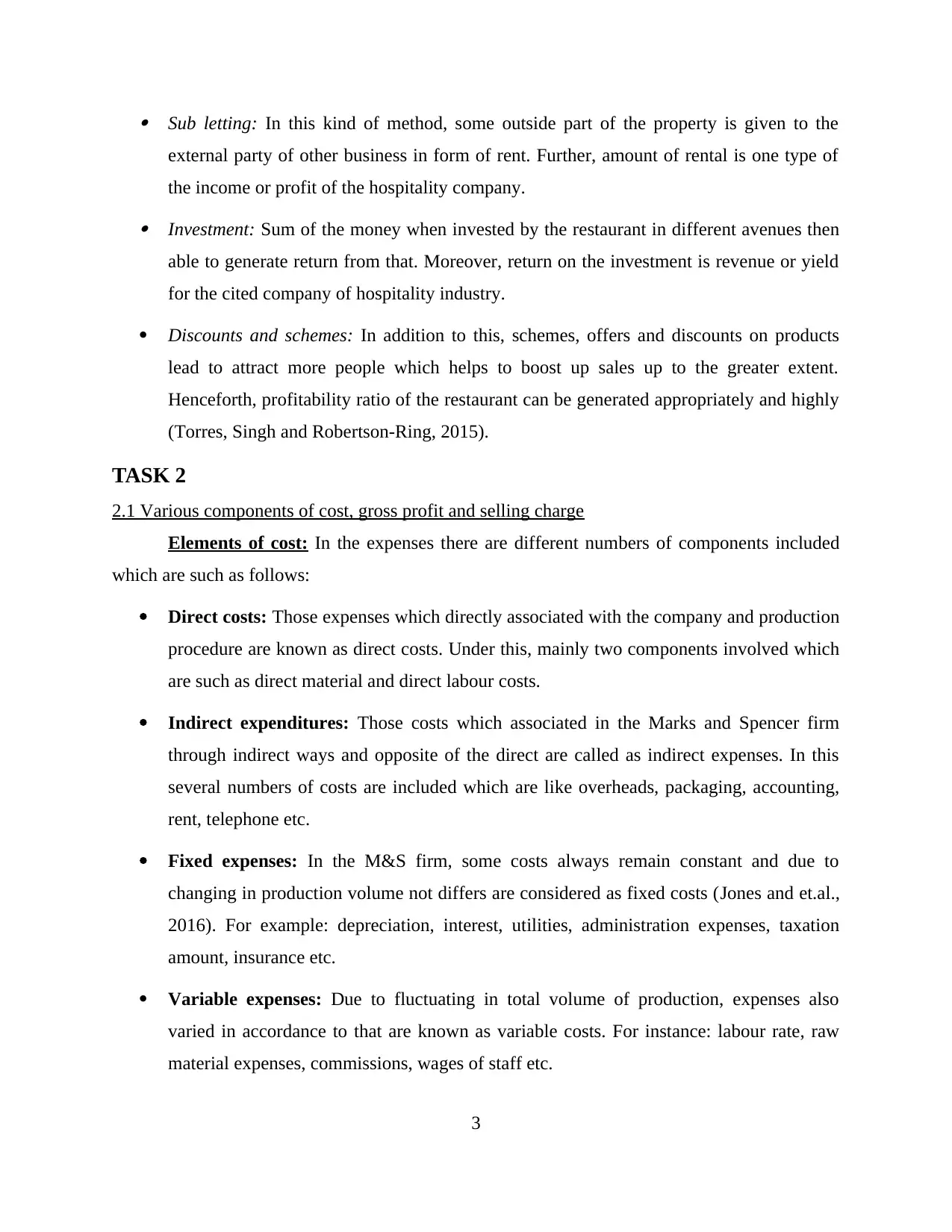
Sub letting: In this kind of method, some outside part of the property is given to the
external party of other business in form of rent. Further, amount of rental is one type of
the income or profit of the hospitality company. Investment: Sum of the money when invested by the restaurant in different avenues then
able to generate return from that. Moreover, return on the investment is revenue or yield
for the cited company of hospitality industry.
Discounts and schemes: In addition to this, schemes, offers and discounts on products
lead to attract more people which helps to boost up sales up to the greater extent.
Henceforth, profitability ratio of the restaurant can be generated appropriately and highly
(Torres, Singh and Robertson-Ring, 2015).
TASK 2
2.1 Various components of cost, gross profit and selling charge
Elements of cost: In the expenses there are different numbers of components included
which are such as follows:
Direct costs: Those expenses which directly associated with the company and production
procedure are known as direct costs. Under this, mainly two components involved which
are such as direct material and direct labour costs.
Indirect expenditures: Those costs which associated in the Marks and Spencer firm
through indirect ways and opposite of the direct are called as indirect expenses. In this
several numbers of costs are included which are like overheads, packaging, accounting,
rent, telephone etc.
Fixed expenses: In the M&S firm, some costs always remain constant and due to
changing in production volume not differs are considered as fixed costs (Jones and et.al.,
2016). For example: depreciation, interest, utilities, administration expenses, taxation
amount, insurance etc.
Variable expenses: Due to fluctuating in total volume of production, expenses also
varied in accordance to that are known as variable costs. For instance: labour rate, raw
material expenses, commissions, wages of staff etc.
3
external party of other business in form of rent. Further, amount of rental is one type of
the income or profit of the hospitality company. Investment: Sum of the money when invested by the restaurant in different avenues then
able to generate return from that. Moreover, return on the investment is revenue or yield
for the cited company of hospitality industry.
Discounts and schemes: In addition to this, schemes, offers and discounts on products
lead to attract more people which helps to boost up sales up to the greater extent.
Henceforth, profitability ratio of the restaurant can be generated appropriately and highly
(Torres, Singh and Robertson-Ring, 2015).
TASK 2
2.1 Various components of cost, gross profit and selling charge
Elements of cost: In the expenses there are different numbers of components included
which are such as follows:
Direct costs: Those expenses which directly associated with the company and production
procedure are known as direct costs. Under this, mainly two components involved which
are such as direct material and direct labour costs.
Indirect expenditures: Those costs which associated in the Marks and Spencer firm
through indirect ways and opposite of the direct are called as indirect expenses. In this
several numbers of costs are included which are like overheads, packaging, accounting,
rent, telephone etc.
Fixed expenses: In the M&S firm, some costs always remain constant and due to
changing in production volume not differs are considered as fixed costs (Jones and et.al.,
2016). For example: depreciation, interest, utilities, administration expenses, taxation
amount, insurance etc.
Variable expenses: Due to fluctuating in total volume of production, expenses also
varied in accordance to that are known as variable costs. For instance: labour rate, raw
material expenses, commissions, wages of staff etc.
3
⊘ This is a preview!⊘
Do you want full access?
Subscribe today to unlock all pages.

Trusted by 1+ million students worldwide
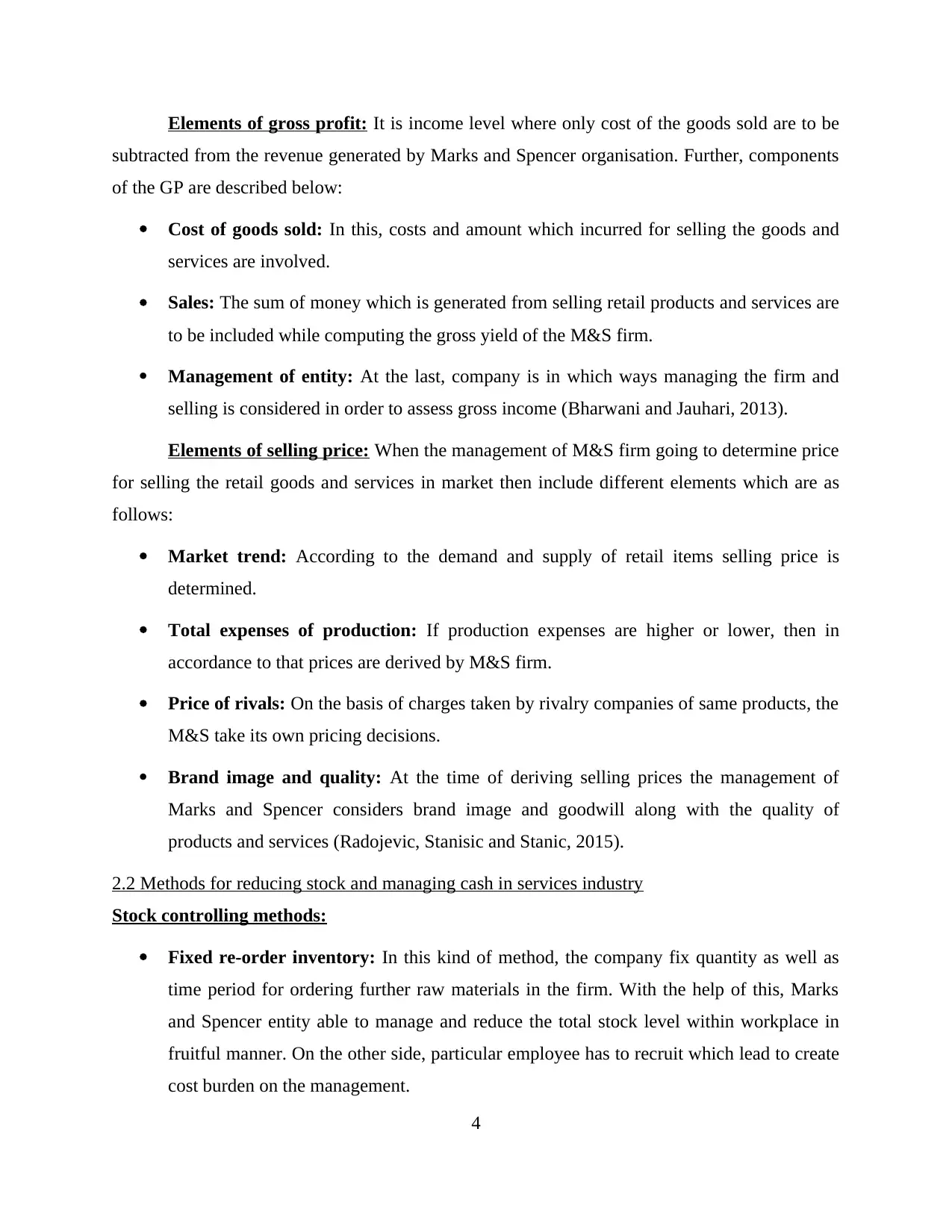
Elements of gross profit: It is income level where only cost of the goods sold are to be
subtracted from the revenue generated by Marks and Spencer organisation. Further, components
of the GP are described below:
Cost of goods sold: In this, costs and amount which incurred for selling the goods and
services are involved.
Sales: The sum of money which is generated from selling retail products and services are
to be included while computing the gross yield of the M&S firm.
Management of entity: At the last, company is in which ways managing the firm and
selling is considered in order to assess gross income (Bharwani and Jauhari, 2013).
Elements of selling price: When the management of M&S firm going to determine price
for selling the retail goods and services in market then include different elements which are as
follows:
Market trend: According to the demand and supply of retail items selling price is
determined.
Total expenses of production: If production expenses are higher or lower, then in
accordance to that prices are derived by M&S firm.
Price of rivals: On the basis of charges taken by rivalry companies of same products, the
M&S take its own pricing decisions.
Brand image and quality: At the time of deriving selling prices the management of
Marks and Spencer considers brand image and goodwill along with the quality of
products and services (Radojevic, Stanisic and Stanic, 2015).
2.2 Methods for reducing stock and managing cash in services industry
Stock controlling methods:
Fixed re-order inventory: In this kind of method, the company fix quantity as well as
time period for ordering further raw materials in the firm. With the help of this, Marks
and Spencer entity able to manage and reduce the total stock level within workplace in
fruitful manner. On the other side, particular employee has to recruit which lead to create
cost burden on the management.
4
subtracted from the revenue generated by Marks and Spencer organisation. Further, components
of the GP are described below:
Cost of goods sold: In this, costs and amount which incurred for selling the goods and
services are involved.
Sales: The sum of money which is generated from selling retail products and services are
to be included while computing the gross yield of the M&S firm.
Management of entity: At the last, company is in which ways managing the firm and
selling is considered in order to assess gross income (Bharwani and Jauhari, 2013).
Elements of selling price: When the management of M&S firm going to determine price
for selling the retail goods and services in market then include different elements which are as
follows:
Market trend: According to the demand and supply of retail items selling price is
determined.
Total expenses of production: If production expenses are higher or lower, then in
accordance to that prices are derived by M&S firm.
Price of rivals: On the basis of charges taken by rivalry companies of same products, the
M&S take its own pricing decisions.
Brand image and quality: At the time of deriving selling prices the management of
Marks and Spencer considers brand image and goodwill along with the quality of
products and services (Radojevic, Stanisic and Stanic, 2015).
2.2 Methods for reducing stock and managing cash in services industry
Stock controlling methods:
Fixed re-order inventory: In this kind of method, the company fix quantity as well as
time period for ordering further raw materials in the firm. With the help of this, Marks
and Spencer entity able to manage and reduce the total stock level within workplace in
fruitful manner. On the other side, particular employee has to recruit which lead to create
cost burden on the management.
4
Paraphrase This Document
Need a fresh take? Get an instant paraphrase of this document with our AI Paraphraser
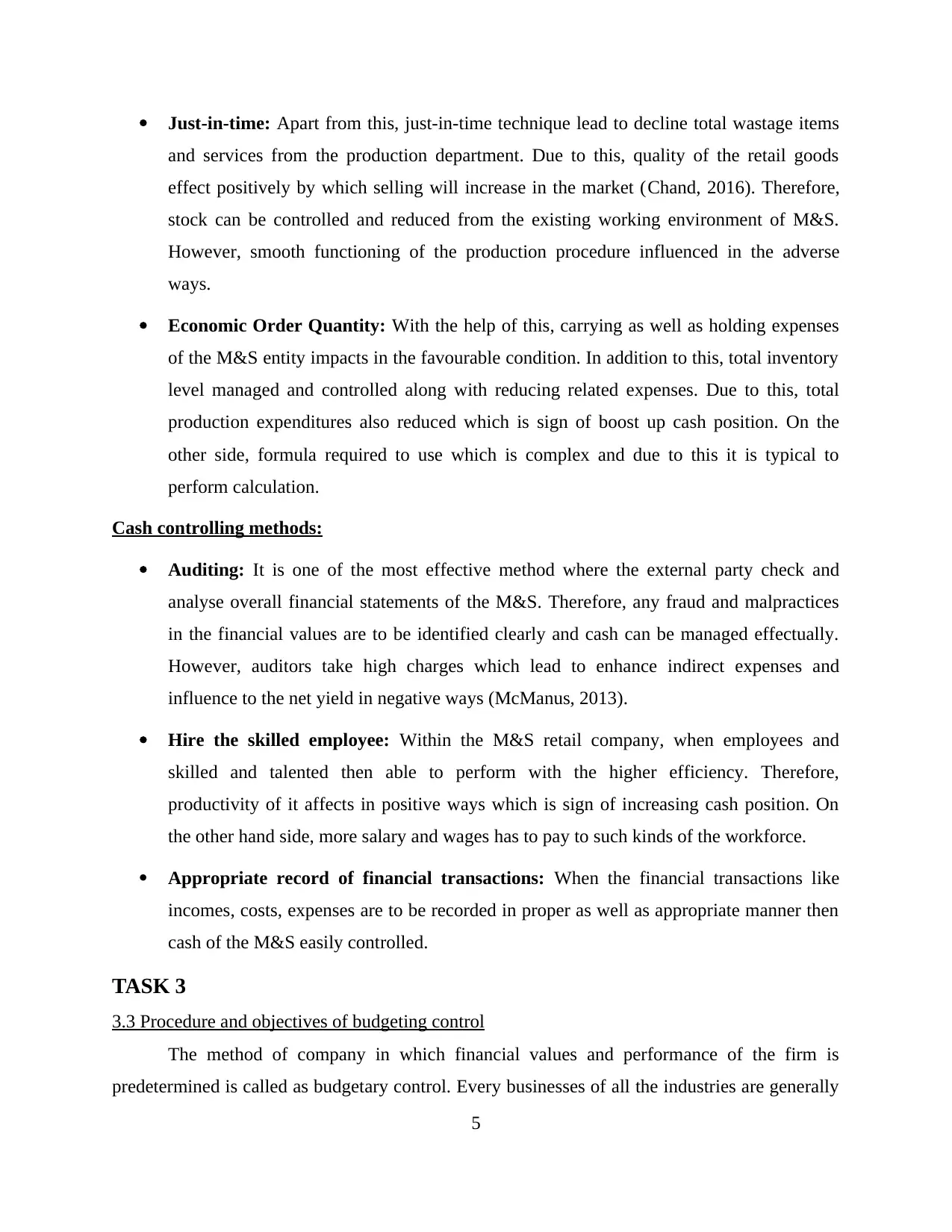
Just-in-time: Apart from this, just-in-time technique lead to decline total wastage items
and services from the production department. Due to this, quality of the retail goods
effect positively by which selling will increase in the market (Chand, 2016). Therefore,
stock can be controlled and reduced from the existing working environment of M&S.
However, smooth functioning of the production procedure influenced in the adverse
ways.
Economic Order Quantity: With the help of this, carrying as well as holding expenses
of the M&S entity impacts in the favourable condition. In addition to this, total inventory
level managed and controlled along with reducing related expenses. Due to this, total
production expenditures also reduced which is sign of boost up cash position. On the
other side, formula required to use which is complex and due to this it is typical to
perform calculation.
Cash controlling methods:
Auditing: It is one of the most effective method where the external party check and
analyse overall financial statements of the M&S. Therefore, any fraud and malpractices
in the financial values are to be identified clearly and cash can be managed effectually.
However, auditors take high charges which lead to enhance indirect expenses and
influence to the net yield in negative ways (McManus, 2013).
Hire the skilled employee: Within the M&S retail company, when employees and
skilled and talented then able to perform with the higher efficiency. Therefore,
productivity of it affects in positive ways which is sign of increasing cash position. On
the other hand side, more salary and wages has to pay to such kinds of the workforce.
Appropriate record of financial transactions: When the financial transactions like
incomes, costs, expenses are to be recorded in proper as well as appropriate manner then
cash of the M&S easily controlled.
TASK 3
3.3 Procedure and objectives of budgeting control
The method of company in which financial values and performance of the firm is
predetermined is called as budgetary control. Every businesses of all the industries are generally
5
and services from the production department. Due to this, quality of the retail goods
effect positively by which selling will increase in the market (Chand, 2016). Therefore,
stock can be controlled and reduced from the existing working environment of M&S.
However, smooth functioning of the production procedure influenced in the adverse
ways.
Economic Order Quantity: With the help of this, carrying as well as holding expenses
of the M&S entity impacts in the favourable condition. In addition to this, total inventory
level managed and controlled along with reducing related expenses. Due to this, total
production expenditures also reduced which is sign of boost up cash position. On the
other side, formula required to use which is complex and due to this it is typical to
perform calculation.
Cash controlling methods:
Auditing: It is one of the most effective method where the external party check and
analyse overall financial statements of the M&S. Therefore, any fraud and malpractices
in the financial values are to be identified clearly and cash can be managed effectually.
However, auditors take high charges which lead to enhance indirect expenses and
influence to the net yield in negative ways (McManus, 2013).
Hire the skilled employee: Within the M&S retail company, when employees and
skilled and talented then able to perform with the higher efficiency. Therefore,
productivity of it affects in positive ways which is sign of increasing cash position. On
the other hand side, more salary and wages has to pay to such kinds of the workforce.
Appropriate record of financial transactions: When the financial transactions like
incomes, costs, expenses are to be recorded in proper as well as appropriate manner then
cash of the M&S easily controlled.
TASK 3
3.3 Procedure and objectives of budgeting control
The method of company in which financial values and performance of the firm is
predetermined is called as budgetary control. Every businesses of all the industries are generally
5
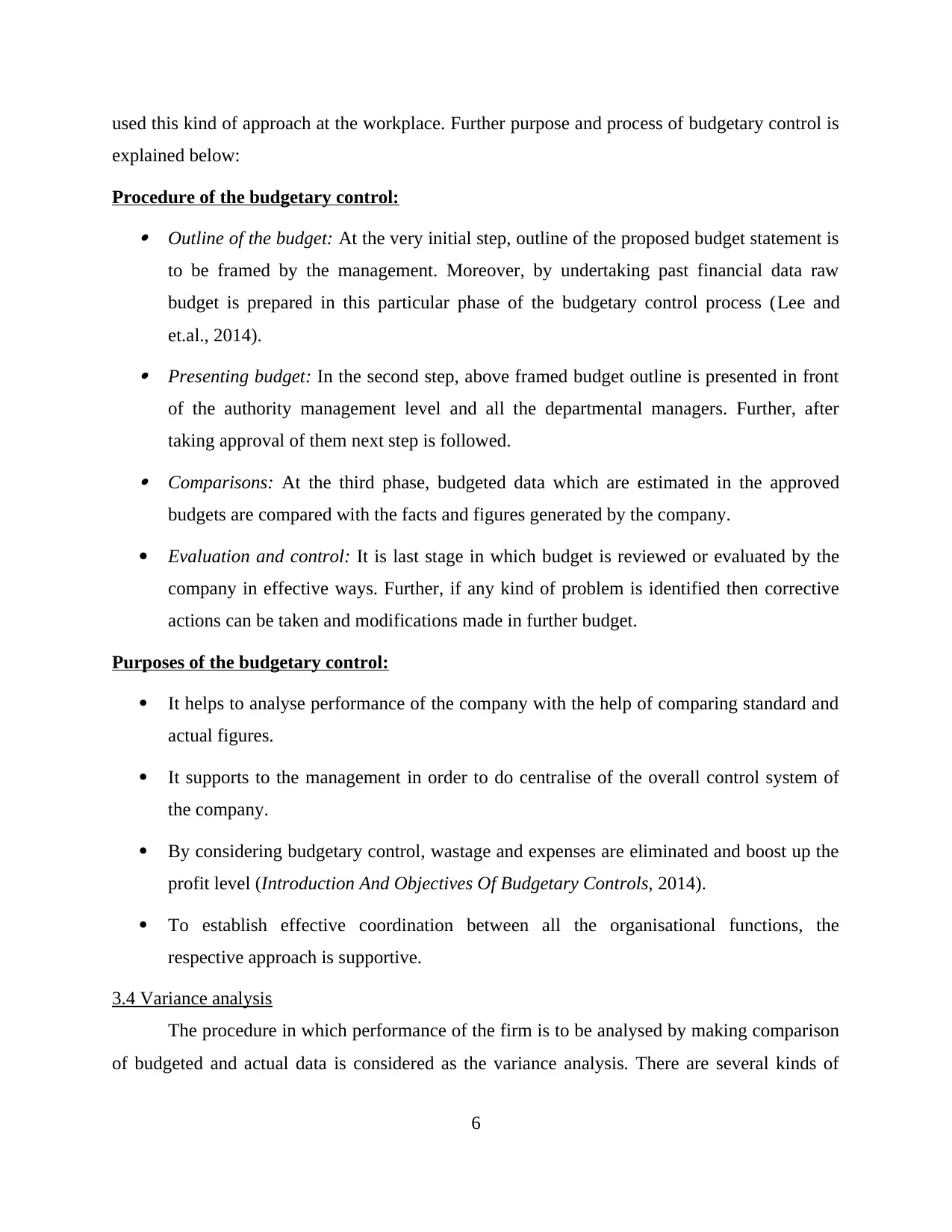
used this kind of approach at the workplace. Further purpose and process of budgetary control is
explained below:
Procedure of the budgetary control: Outline of the budget: At the very initial step, outline of the proposed budget statement is
to be framed by the management. Moreover, by undertaking past financial data raw
budget is prepared in this particular phase of the budgetary control process (Lee and
et.al., 2014). Presenting budget: In the second step, above framed budget outline is presented in front
of the authority management level and all the departmental managers. Further, after
taking approval of them next step is followed. Comparisons: At the third phase, budgeted data which are estimated in the approved
budgets are compared with the facts and figures generated by the company.
Evaluation and control: It is last stage in which budget is reviewed or evaluated by the
company in effective ways. Further, if any kind of problem is identified then corrective
actions can be taken and modifications made in further budget.
Purposes of the budgetary control:
It helps to analyse performance of the company with the help of comparing standard and
actual figures.
It supports to the management in order to do centralise of the overall control system of
the company.
By considering budgetary control, wastage and expenses are eliminated and boost up the
profit level (Introduction And Objectives Of Budgetary Controls, 2014).
To establish effective coordination between all the organisational functions, the
respective approach is supportive.
3.4 Variance analysis
The procedure in which performance of the firm is to be analysed by making comparison
of budgeted and actual data is considered as the variance analysis. There are several kinds of
6
explained below:
Procedure of the budgetary control: Outline of the budget: At the very initial step, outline of the proposed budget statement is
to be framed by the management. Moreover, by undertaking past financial data raw
budget is prepared in this particular phase of the budgetary control process (Lee and
et.al., 2014). Presenting budget: In the second step, above framed budget outline is presented in front
of the authority management level and all the departmental managers. Further, after
taking approval of them next step is followed. Comparisons: At the third phase, budgeted data which are estimated in the approved
budgets are compared with the facts and figures generated by the company.
Evaluation and control: It is last stage in which budget is reviewed or evaluated by the
company in effective ways. Further, if any kind of problem is identified then corrective
actions can be taken and modifications made in further budget.
Purposes of the budgetary control:
It helps to analyse performance of the company with the help of comparing standard and
actual figures.
It supports to the management in order to do centralise of the overall control system of
the company.
By considering budgetary control, wastage and expenses are eliminated and boost up the
profit level (Introduction And Objectives Of Budgetary Controls, 2014).
To establish effective coordination between all the organisational functions, the
respective approach is supportive.
3.4 Variance analysis
The procedure in which performance of the firm is to be analysed by making comparison
of budgeted and actual data is considered as the variance analysis. There are several kinds of
6
⊘ This is a preview!⊘
Do you want full access?
Subscribe today to unlock all pages.

Trusted by 1+ million students worldwide
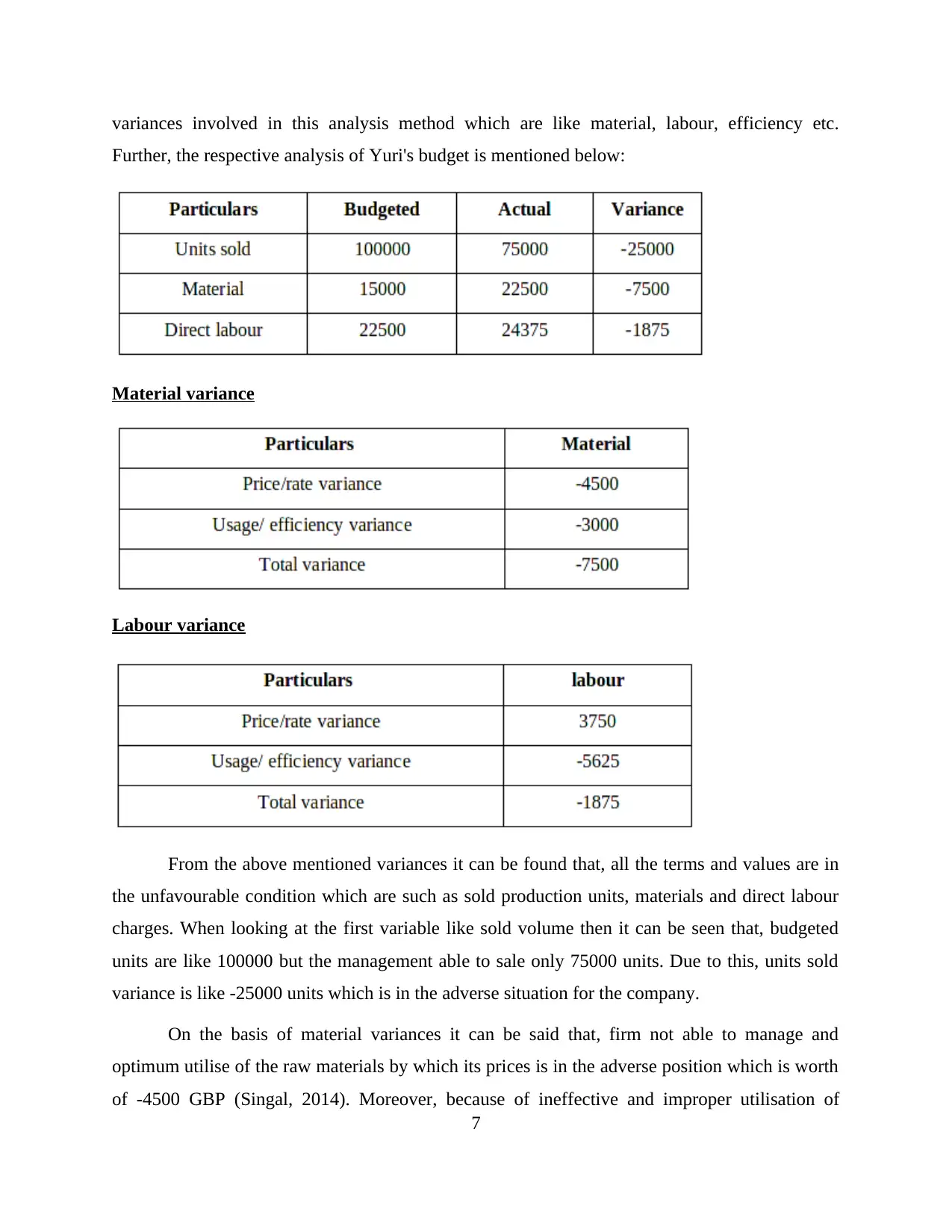
variances involved in this analysis method which are like material, labour, efficiency etc.
Further, the respective analysis of Yuri's budget is mentioned below:
Material variance
Labour variance
From the above mentioned variances it can be found that, all the terms and values are in
the unfavourable condition which are such as sold production units, materials and direct labour
charges. When looking at the first variable like sold volume then it can be seen that, budgeted
units are like 100000 but the management able to sale only 75000 units. Due to this, units sold
variance is like -25000 units which is in the adverse situation for the company.
On the basis of material variances it can be said that, firm not able to manage and
optimum utilise of the raw materials by which its prices is in the adverse position which is worth
of -4500 GBP (Singal, 2014). Moreover, because of ineffective and improper utilisation of
7
Further, the respective analysis of Yuri's budget is mentioned below:
Material variance
Labour variance
From the above mentioned variances it can be found that, all the terms and values are in
the unfavourable condition which are such as sold production units, materials and direct labour
charges. When looking at the first variable like sold volume then it can be seen that, budgeted
units are like 100000 but the management able to sale only 75000 units. Due to this, units sold
variance is like -25000 units which is in the adverse situation for the company.
On the basis of material variances it can be said that, firm not able to manage and
optimum utilise of the raw materials by which its prices is in the adverse position which is worth
of -4500 GBP (Singal, 2014). Moreover, because of ineffective and improper utilisation of
7
Paraphrase This Document
Need a fresh take? Get an instant paraphrase of this document with our AI Paraphraser
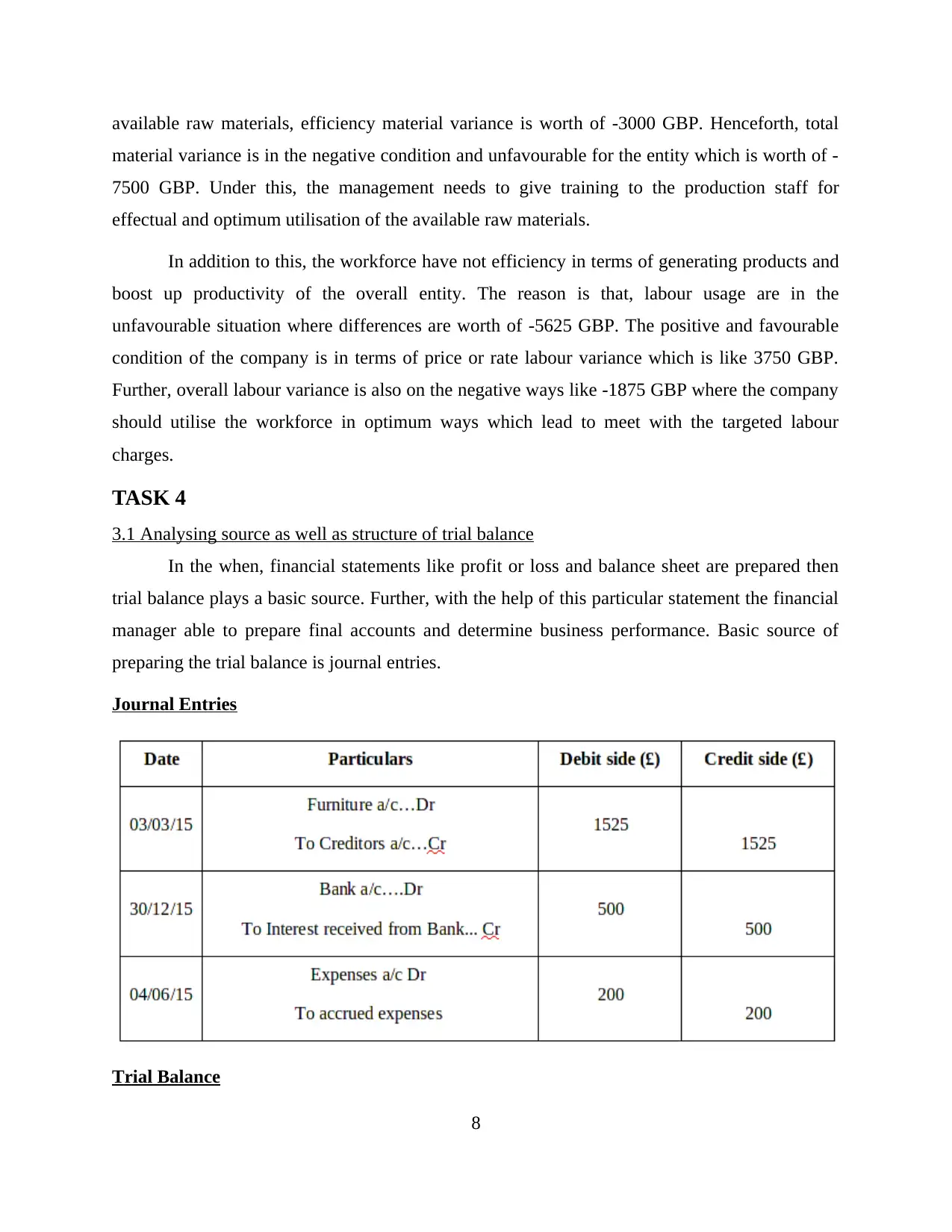
available raw materials, efficiency material variance is worth of -3000 GBP. Henceforth, total
material variance is in the negative condition and unfavourable for the entity which is worth of -
7500 GBP. Under this, the management needs to give training to the production staff for
effectual and optimum utilisation of the available raw materials.
In addition to this, the workforce have not efficiency in terms of generating products and
boost up productivity of the overall entity. The reason is that, labour usage are in the
unfavourable situation where differences are worth of -5625 GBP. The positive and favourable
condition of the company is in terms of price or rate labour variance which is like 3750 GBP.
Further, overall labour variance is also on the negative ways like -1875 GBP where the company
should utilise the workforce in optimum ways which lead to meet with the targeted labour
charges.
TASK 4
3.1 Analysing source as well as structure of trial balance
In the when, financial statements like profit or loss and balance sheet are prepared then
trial balance plays a basic source. Further, with the help of this particular statement the financial
manager able to prepare final accounts and determine business performance. Basic source of
preparing the trial balance is journal entries.
Journal Entries
Trial Balance
8
material variance is in the negative condition and unfavourable for the entity which is worth of -
7500 GBP. Under this, the management needs to give training to the production staff for
effectual and optimum utilisation of the available raw materials.
In addition to this, the workforce have not efficiency in terms of generating products and
boost up productivity of the overall entity. The reason is that, labour usage are in the
unfavourable situation where differences are worth of -5625 GBP. The positive and favourable
condition of the company is in terms of price or rate labour variance which is like 3750 GBP.
Further, overall labour variance is also on the negative ways like -1875 GBP where the company
should utilise the workforce in optimum ways which lead to meet with the targeted labour
charges.
TASK 4
3.1 Analysing source as well as structure of trial balance
In the when, financial statements like profit or loss and balance sheet are prepared then
trial balance plays a basic source. Further, with the help of this particular statement the financial
manager able to prepare final accounts and determine business performance. Basic source of
preparing the trial balance is journal entries.
Journal Entries
Trial Balance
8
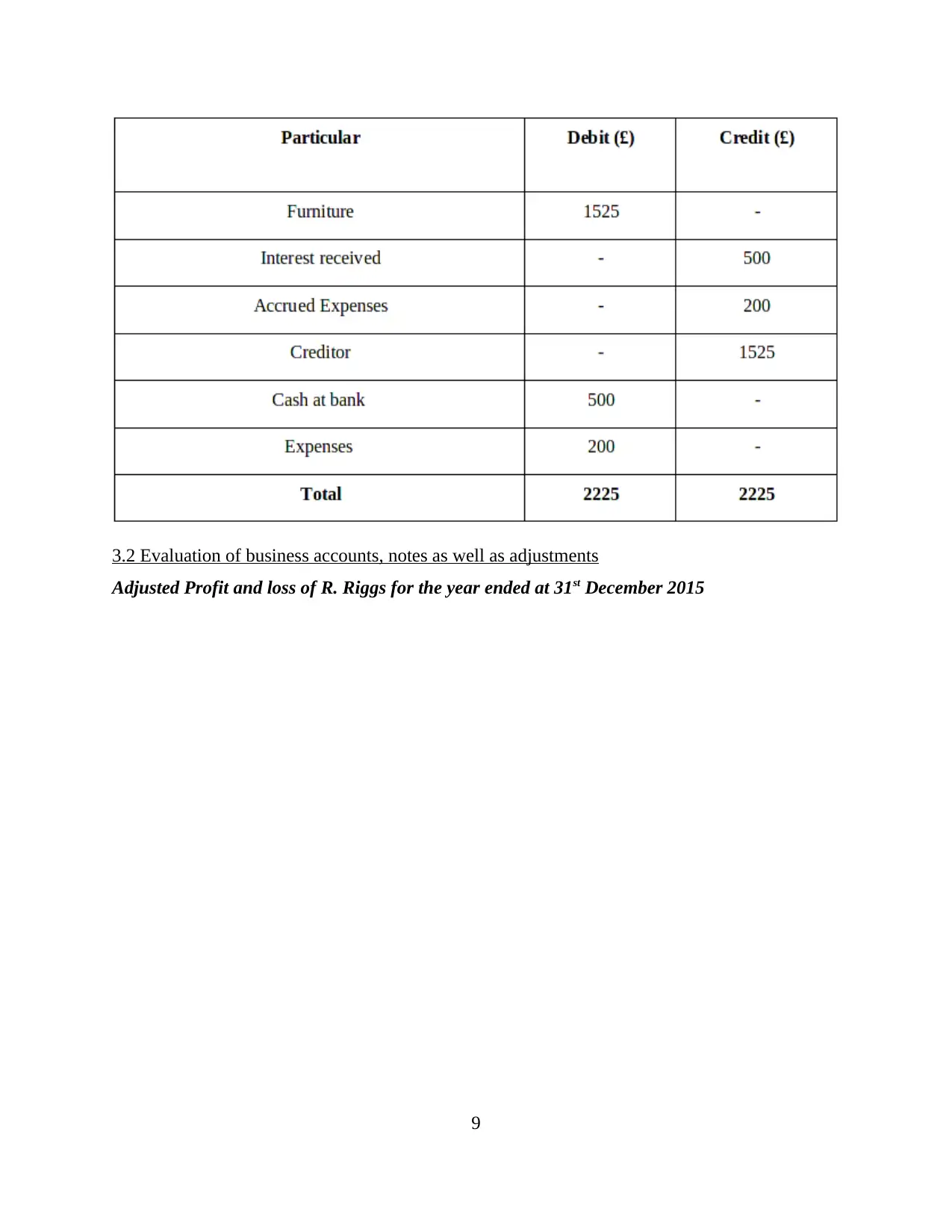
3.2 Evaluation of business accounts, notes as well as adjustments
Adjusted Profit and loss of R. Riggs for the year ended at 31st December 2015
9
Adjusted Profit and loss of R. Riggs for the year ended at 31st December 2015
9
⊘ This is a preview!⊘
Do you want full access?
Subscribe today to unlock all pages.

Trusted by 1+ million students worldwide
1 out of 25
Related Documents
Your All-in-One AI-Powered Toolkit for Academic Success.
+13062052269
info@desklib.com
Available 24*7 on WhatsApp / Email
![[object Object]](/_next/static/media/star-bottom.7253800d.svg)
Unlock your academic potential
Copyright © 2020–2025 A2Z Services. All Rights Reserved. Developed and managed by ZUCOL.





